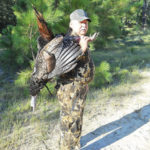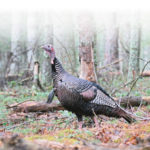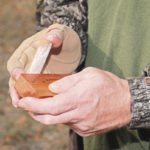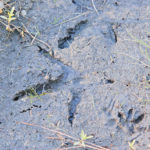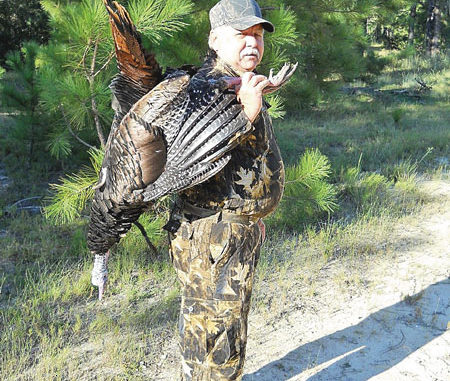
State offers fall turkey shoot at popular WMA
“Déjà vu all over again.” That’s what former New York Yankees catching great Yogi Berra called it, and I got a taste of it last hunting season.
In the mail, on official government letterhead, I was congratulated for being selected as one of 100 lottery applicants to participate in the first-ever fall turkey hunt on Peason Ridge Wildlife Management Area Oct. 2-8, 2010.
Strangely enough, there was one other time a notice of winning a lottery had come on government letterhead. That one was from President Nixon notifying me that I, along with other men my age with my birthday, had been randomly selected for the U.S. Army draft. Even stranger, that 30 year-old letter sent me to Fort Polk and Peason Ridge for basic training, exactly the same place I would be hunting turkeys instead of playing war games in a place designed to resemble South Vietnam.
Back then the way it was determined who had the honor of
serving their country was a draft lottery. In 1970, Congress instituted a random selection process for the military draft. All 366 possible birth dates were placed in plastic capsules in a rotating drum, and were selected one by one. The first date drawn from the drum received draft No. 1, and eligible men born on that date were drafted first. My birthday was drawn 51st, which sent me packing with the very first group.
Lucky me!
But this lottery was much, much different. It was for the
opportunity to make Louisiana turkey hunting history, and when the good news came, my fellow applicants and I were excited about the prospects of hunting turkeys when normally we might be bowhunting deer or shotgunning for squirrels.
Turkey hunting history
Armed with our lottery winning permits, Rick Gottardi of Lacombe, Jeff Anastasio of Covington, C.J. Trahan of Westlake and I emerged from war-room conversations with the following plan. Reserve a room at a nearby motel in Leesville to set up a temporary headquarters, and hunt as hard as we could for as long as our schedules would allow.
The first bad news came before we could pack our last camo facemask. Our best turkey scout, Jeff, was out due to family obligations and would be missed. Rick and C.J. took off Friday to take advantage of whatever daylight would be left to get a feel for at least the lay of the land, if not roost a bird.
Just like the last 22 years, because of my early Saturday morning radio obligations, I would miss opening morning, but I planned to join them for at least an opening-day evening hunt.
It didn’t take long for the plan to become successful. Rick and C.J. were hunting that opening Saturday morning while I was on the radio. Having never set foot on the place before, they chose positions at some “turkey-looking” spots they had scouted the previous evening.
As luck would have it, when they arrived before daylight that opening morning, a truck was already parked in their spot. They headed a ways down the road, split up and in the dark walked into totally unfamiliar woods. Within minutes of legal shooting time, a single tom walked right up to C.J. who had barely settled his back against a tree, and the rest is Louisiana Fall Turkey Lottery history.
Within minutes, Rick and C.J. were on the radio by cell phone with me reporting the not-even-cold-yet turkey. Since the one turkey allowed during that week-long fall season counted against hunters’ two tags, C.J.’s hunt was over in record time. Rick’s and mine were just beginning.
Spring vs. fall
I’m sure where fall turkey hunting is an established tradition, there are hunters who have developed tactics that increase the odds of bagging a bird that doesn’t have to wait in the freezer for seven months before its appearance on the Thanksgiving Day table. Being this is totally new to Louisiana hunters, it was as much a learning process as a hunting experience.
Even though I had sought out as much information as possible about fall turkey techniques, it’s still a little mystifying to me, but probably not C.J. Sure wish I could adopt his methodology, but I don’t think he can explain it either.
First thing about hunting gobblers in the fall is they don’t gobble, at least not very much. So all those diaphragm, slate and box calls that weigh us down in the spring are pretty much useless, right? Not so fast yelp-breath. Turkeys communicate 12 months a year, and learning their lingo can be used to bag an October bird.
Sure, they’re not gobbling their little heads off trying to attract every hen with 5 miles, but they use clucks, purrs, whines, etc., to keep in touch and reassure each other no hungry coyote, bobcat, hawk or coonass is planning an ambush while they travel with the flock.
Speaking of flocks, fall turkey flocks are much larger than what we see in the March-April hunting months. The trick, as I’m learning, is to get in position to have those lollygagging flocks meander past you, allowing you to pick a mature gobbler on which to center your shotgun bead.
Over the four days I hunted, I saw hundreds of turkeys within either earshot or gun range, and put my best calling skills to the test. The result was they paid very little attention to my calls, probably because there was so much “talk” going on, my calls just blended in and did nothing to alter their routes, much less bring them closer. Calls that have resulted in dead turkeys for me in spring were about as useless as BBs at King Kong.
So other than relying on good positioning in areas that turkeys are regularly using (which I easily found), and then relying on the luck of a gobbler, instead of hens, randomly passing into gun range (which didn’t happen), what other tactics are available for fall birds?
Roosting birds can be a big advantage. I did that on two
evenings. But even though I returned and set up in the dark, when the birds flew down they simply walked off in a different direction, and no amount of non-breeding season calling could turn them. Hunting flocks with a group will increase the odds simply by surrounding roosted birds, but with Jeff a no-show, C.J. and his ice-packed bird headed back to Westlake, it was down to me and Rick.
And now with one day left, Rick got the call from his office — duty calls — and I was on my own. After he left, I roosted a flock that evening and made a promise that I would go into siege mode the final day. I packed drinks and a sandwich and vowed I would stay in that area from daylight until as long as it took, even right up to the end of legal shooting time.
And that’s exactly what I did. I saw plenty of turkeys, had some in range, although not what I was looking for, and finally had to leave with my two tags still intact.
Since then, I’ve had a lot of time to think about what I would do differently next time. Certainly hunting with at least one, maybe two or three other hunters to use the assassination conspiracy theory “triangulation method” on roosting birds would make sense.
But there was something else I came away from that first fall hunt with that I’ll consider. And it’s something that normally you wouldn’t think of as ethical, but actually there’s nothing wrong with it and it could be more effective than anything else. I’m talking about road riding. I’m not talking about shooting through a rolled-down window from a moving truck, but covering the vast amount of gravel roads on Peason Ridge with binoculars to spot tom turkeys, and then planning an ambush.
Two things have me leaning toward this method. First, even though we travelled sparingly to get to our set-up spots, we saw plenty of turkeys on the sides of the roads and in big open fields. Maybe it’s where they gather their grit, or maybe they just use the roads as paths, but those turkeys spend a lot of time on or very near the roads.
The other thing is you have to concentrate where the gobblers are. Finding and hearing hens is no problem, but spotting and identifying the sex of the turkeys before you plan your set up again will increase the odds of getting a legal bird in range.
I also, while in the woods, could hear a lot more vehicles slowly driving the roads than you would expect to be in this remote location. After all, there are no ball parks, malls, convenience stores or anything else in there. Maybe other fall turkey hunters already figured out what I’ve learned.
A spin off of the travelling road show technique might be to find, then bust, those big flocks and then slip into the woods, let things quiet down and then try to use regrouping calls. Again, there’s no guarantee that a gobbler will appear in range.
Fall lottery philosophy
While several other states have fall turkey seasons, last season’s chance was unique for Bayou State hunters. In order to take advantage of a very healthy wild turkey population, and to help satisfy an ever-growing thirst for turkey hunting on public lands, LDWF proposed this special one-week season to a limited number of hunters on one of its prime turkey hunting WMAs, Peason Ridge.
Peason Ridge WMA is located 18 miles north of Leesville, and stretches across Sabine, Natchitoches and Vernon parishes. Its 33,488 acres of gentle to high rolling hills interspersed with creeks and greenheads are owned by the U.S. Army. Longleaf pine is dominant on some of the hills, while a mixture of loblolly pine, longleaf pine, red oak, blackjack oak and post oak is found on other ridges. Large areas with little or no timber are perfect for scouting flocks of fall turkeys.
Besides turkeys, game species available for hunting include deer, squirrel, rabbit, quail, woodcock and doves. Trapping is allowed for raccoon, fox, bobcat, skunk, opossum, mink and coyote. All hunters and trappers must obtain an annual permit from the U.S. Army.
There is a unique population of wild horses that graze across those hillsides and do an excellent job of keeping the grass cropped closely. Encounters with these herds while hunting on Peason Ridge, while hardly a threat, make the area even that much more interesting.
Even more interesting are the military operations that take place there. Back when I was stationed and trained there, one area was called “Tigerland.” This zone simulated conditions that would prepare soldiers for Vietnam. As you might guess, now it’s been transformed to a mini Middle East. Along the gravel roads you’re going to see road-bombed vehicles, downed helicopters, cutouts of turban-wearing Muslims surrendering hands-up, camels, sheep, right down to simulated huts and villages.
Driving through these areas and practice ranges is a strange reminder that our freedom to hunt there was made possible because of the thousands of soldiers who have trained there for decades.
